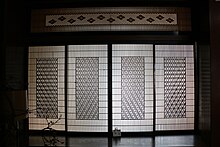
Kumiko (Japanese: 組子) is a Japanese technique of assembling wooden pieces without the use of nails.[1]

Kumiko (Japanese: 組子) is a Japanese technique of assembling wooden pieces without the use of nails.[1]
Thinly slit wooden pieces are grooved, punched and mortised, and then fitted individually using a plane, saw, chisel and other tools to make fine adjustments. The technique was developed in Japan in the Asuka Era (600–700 AD).[2][1] Kumiko panels slot together and remain in place through pressure alone, and that pressure is achieved through meticulously calculating, cutting, and arranging interweaving joints. The end result is a complex pattern that is used primarily in the creation of shoji doors and screens.[3] Traditionally, the wood of choice was the hinoki cypress.[4]

The designs for kumiko pieces aren't chosen randomly. Many of the nearly 200 patterns used today have been around since the Edo era (1603–1868). Each design has a meaning or is mimicking a pattern in nature that is thought to be a good omen. The patterns are designed to look good, but also to distribute light and wind in a calming and beautiful way.[5]
Traditionally it is made with hand tools only, but in the western society they have made new techniques to make these kinds of patterns, it involves a table saw, a sharp chisel and some guides made by yourself, some can be made with plywood and some need to be made with hard or soft wood.